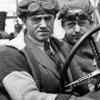Came across a reference to a sprint car built for Raymond Mays in 1949 or 50, fitted with a 2-litre supercharged engine delivering 320 bhp. Neither the car nor the engine is named, and I am wondering if anyone knows of it, and of its competition history.
Sorry I am unable to post an attachment, more so as it is in a pdf file, so all I can do is summarise what material I have.
The brief description refers to the rather extreme 33/67 front/rear weight distribution, intentionally arranged for the best traction. This is achieved by setting the engine well back in the frame, locating the gearbox under the driver’s seat, and bolting it directly to the worm-and-wheel “final” drive. The half-shafts from this latter have triplex sprockets at their outer ends, with chains leading forward to either wheel. The casings for these chains thus form leading arms for the IRS. A single rear brake is located right aft, at the extended end of the worm shaft, not unlike some BRMs of a few years later. Front suspension is apparently of the typical Porsche/Volkswagen trailing-arm type, though Lockheed air struts are used instead of torsion bars. The same springing medium is also used at the rear.
That chain drive seems to be a rather more sophisticated version of the arrangement used on some Trojan models of the 20s and 30s.
















